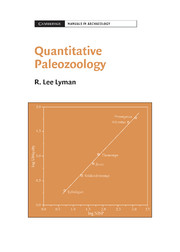Book contents
- Frontmatter
- Contents
- List of figures
- List of tables
- Preface
- 1 Tallying and Counting: Fundamentals
- 2 Estimating Taxonomic Abundances: NISP and MNI
- 3 Estimating Taxonomic Abundances: Other Methods
- 4 Sampling, Recovery, and Sample Size
- 5 Measuring the Taxonomic Structure and Composition (“Diversity”) of Faunas
- 6 Skeletal Completeness, Frequencies of Skeletal Parts, and Fragmentation
- 7 Tallying for Taphonomy: Weathering, Burning, Corrosion, and Butchering
- 8 Final Thoughts
- Glossary
- References
- Index
7 - Tallying for Taphonomy: Weathering, Burning, Corrosion, and Butchering
Published online by Cambridge University Press: 05 June 2012
- Frontmatter
- Contents
- List of figures
- List of tables
- Preface
- 1 Tallying and Counting: Fundamentals
- 2 Estimating Taxonomic Abundances: NISP and MNI
- 3 Estimating Taxonomic Abundances: Other Methods
- 4 Sampling, Recovery, and Sample Size
- 5 Measuring the Taxonomic Structure and Composition (“Diversity”) of Faunas
- 6 Skeletal Completeness, Frequencies of Skeletal Parts, and Fragmentation
- 7 Tallying for Taphonomy: Weathering, Burning, Corrosion, and Butchering
- 8 Final Thoughts
- Glossary
- References
- Index
Summary
Taphonomy is a term coined by Russian paleontologist I. A. Efremov (1940) from the Greek words taphos (burial) and nomos (law). Efremov meant for taphonomy to specify the transition, in all details, of organics from the biosphere to the lithosphere. In the context of this book (recall Figure 2.1), taphonomy concerns the agents and process(es) that influence an animal carcass from the moment of that animal's death until its remains (if any survive the vicissitudes of time) are recovered by the paleozoologist, and also the kind and magnitude of those influences. There are a plethora of taphonomic agents and processes that variously disarticulate, disperse, alter, and destroy carcass tissues, including bones and teeth (Lyman 1994c).
In this chapter, techniques for tallying what are sometimes referred to as taphonomic signatures, features, or attributes evident on faunal remains are introduced. Identifying the taphonomic agents and processes that influenced an assemblage of faunal remains assists interpretation of the remains. (If the agent is biological, then the taphonomic feature is a trace fossil [Gautier 1993; Kowalewski 2002].) Do, for example, those remains reflect what human hunters ate or do they represent a fluvially winnowed set of skeletons of animals that died during a seasonal crossing of a river at flood stage? Determination of the taphonomic history of a collection of faunal remains may reveal aspects of paleoecology not otherwise evident among the collection of remains, such as evidence of carnivore gnawing on ungulate bones when no carnivore remains are recovered.
- Type
- Chapter
- Information
- Quantitative Paleozoology , pp. 264 - 298Publisher: Cambridge University PressPrint publication year: 2008
- 1
- Cited by



